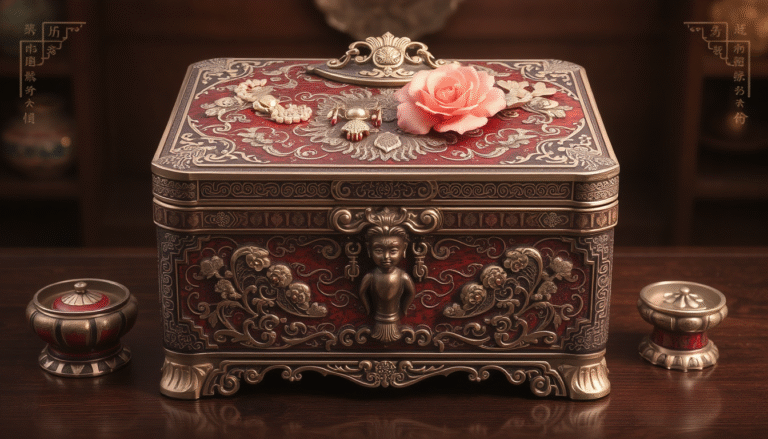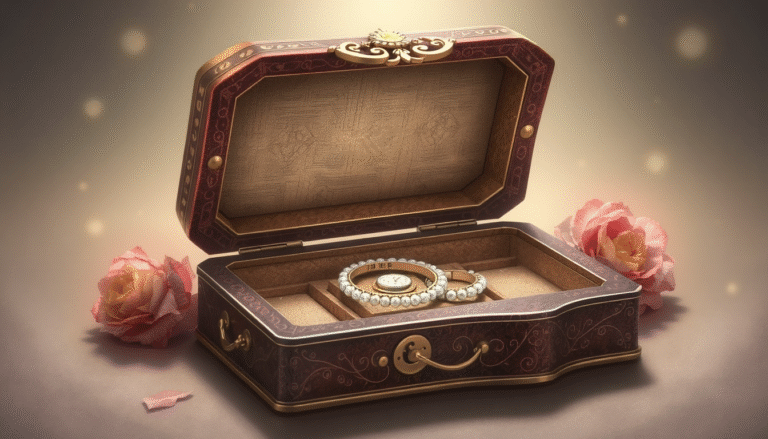More Than a Box: The Enduring Artistry and Symbolism of the Chinese Jewelry Box
Introduction: Unlocking the Secrets of a Timeless Treasure
To reduce it to nothing more than a box would be to miss the point completely. It is not simply a storage container, but rather a vessel for history, for art, and for precious meaning, designed to be as valuable as the treasures it contains.
A Chinese jewelry box is a work of art. This delicate container is a reflection of skills and cultural symbols developed over thousands of years.
We will figure out what hidden secrets these little boxes hold. Together, we’ll explore their fascinating history, how master artisans forge these masterpieces, the stories behind the symbols, and how to care for these heirloom pieces through generations.
A Legacy in Lacquer and Wood: The History and Cultural Heart of the Chinese Jewelry Box
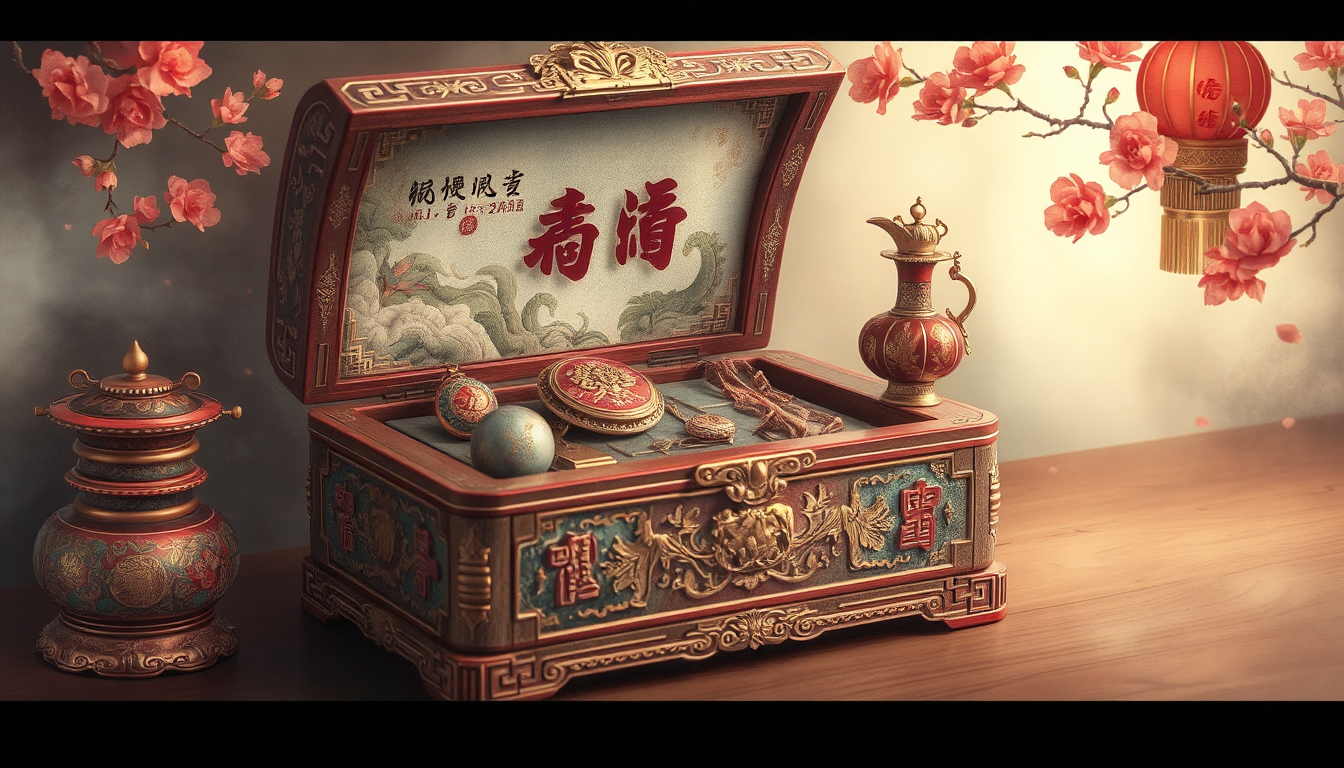
The tale of the Chinese jewelry box becomes woven into the greater story of Chinese furniture and art. Flocking boxes like these developed over centuries and reached the peak of their beauty in the Ming and Qing Dynasties (1368-1912).
Now was a golden age for Chinese furniture design. Artisans who produced large cabinets and tables also made simple smaller boxes with the same painstaking skill and care.
To own a Chinese jewelry box was more than a luxury of possession. It carried significant cultural significance and was often offered as part of a bride’s dowry to display a family’s wealth and standing.
These were boxes for special occasions to be considered thoughtful gifts. They actually served not only to store jewelry, but a person’s most precious possessions — letters, seals, or small trinkets that were meaningful to them.
The Soul of the Artisan: A Guide to Materials and Craftsmanship
Understanding a Chinese jewelry box starts with knowing about its materials. The wood choice, the shine of its finish, and its detailed decorations all tell a story.
Prized Woods and Finishes
Box is made from wooden. Artisans selected particular species of wood, not merely for their ability to resist breaking, but for the appearance and scent of the cutter.
Rosewood (Hongmu)is one of the most treasured woods. A heavy, hard and reddish-brown coloured wood of a fine grain which when polished produces a rich sheen. Its durability rendered it ideal for highly finished articles that would be passed down through generations.
Camphor Wood (Zhangmu) was selected. Not only does it have a sweet pleasant odor that repels bugs naturally, it is perfect for boxes that preserved priceless silks and gems.
Elm Wood (Yumu), with its striking grain pattern, was a common but respected choice. It is strong and tough, making it useful for many types of furniture and boxes.
| Wood Type | Key Characteristics | Common Use |
| Rosewood (红木) | Deep reddish-brown color, dense, durable, often has a fragrant scent. | High-end, classic furniture and boxes. |
| Camphor Wood (樟木) | Lighter color, distinctive aromatic scent (natural insect repellent). | Chests and boxes for storing textiles and valuables. |
| Elm Wood (榆木) | Prominent, beautiful grain, strong and resilient. | A common and versatile choice for furniture and boxes. |
The most well-known finish for such boxes is lacquer. This is no mere varnish. Chinese traditional lacquer is a craft that has been developed over 2000 years. It is made from the sap of the lacquer tree and often is painted on in many layers that are very thin. Each layer must be allowed to fully dry before the next coat is added, and this may take months. This meticulous process creates a polished finish with incredible depth and reflectivity.
Embellishments of Jade, Metal, and Silk
The beauty of a Chinese jewelry box shines through in its decorations. These are never random; each material has its own meaning.
Jade inlaysindicate a quality box. In Chinese tradition, jade symbolizes purity, wisdom, and protection. Inlaid into the wood were finely hewn jade panels that provided the ideal coolness and smoothness contrast to the warmth of the wood grain.
Brass fittings while meant to be functional, also add to the aesthetics of the kitchen. Heavy-duty brass hinges, corner guards and clasps were made to endure, and frequently made in designs of their own. Most had round brass plates fastening with pin-locks in the “Shou” character for longevity.
Inside the box, you would find silk brocade linings. The interior was often lined with fine silk with woven patterns of flowers or geometric designs that matched the outside design.
Decoding the Symbolism: What Your Chinese Jewelry Box is Telling You
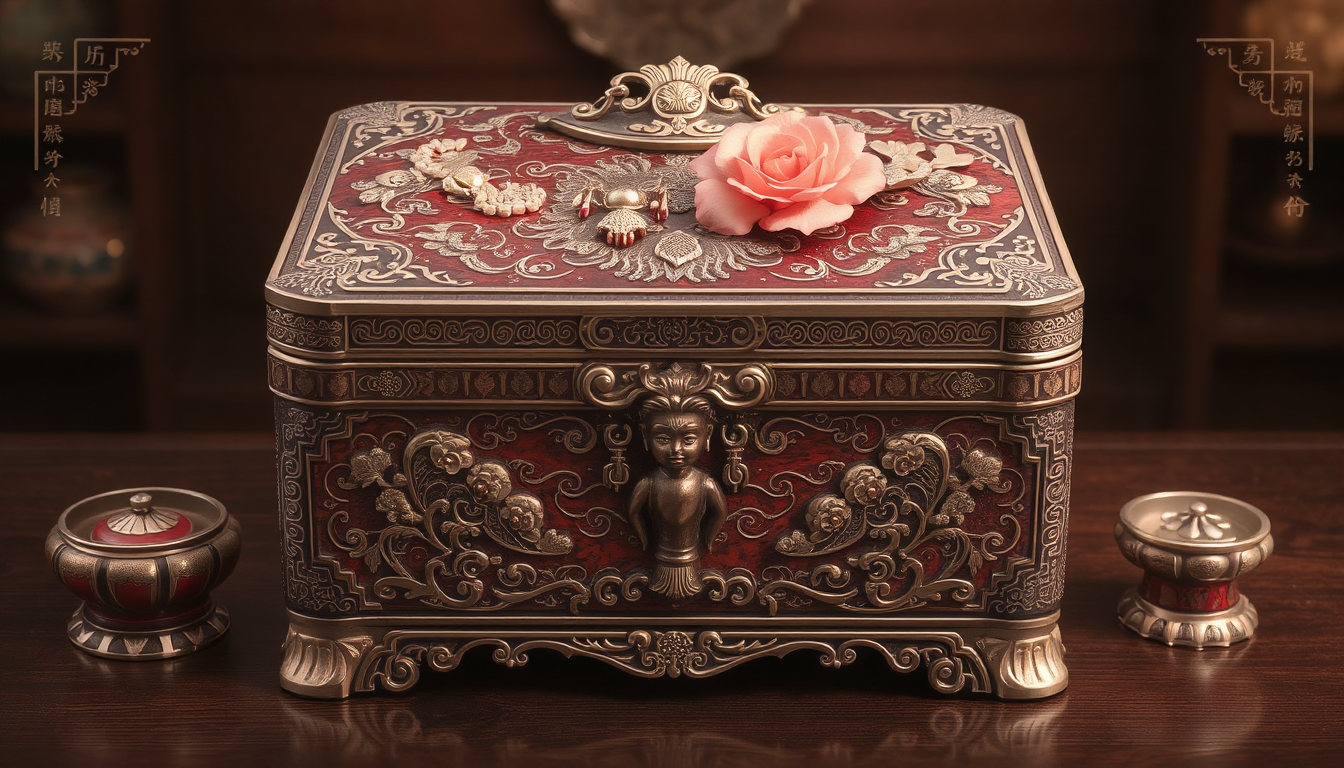
To view a classic Chinese jewelry box is to study a story written in symbols. Each carved figure and painted flower has significance, intended to bring good fortune to the owner. And when you can read this visual language, the box is more than just beautiful — it’s personally meaningful.
These are not etchings or pretty things; they are expressions of hope, good wishes. These are some of the usual suspects, and how they read:
-
Dragons and Phoenixes (龙凤): This is the highest sign of a good marriage. The dragon represents the Emperor and the male energy, and the phoenix symbolizes the Empress and the female power. They combined convey a perfect, harmonious marriage.
-
Peonies (牡丹): As the “King of Flowers,” the peony represents wealth, honor, and success through the lush and colorful flower. Having it on a jewelry box means great wealth and social standing to the owner.
-
Bats (蝠): How is this a good visual pun? The word for bat, fú, is a homonym of the word for good luck (福). Five bats that flock together also are a symbol of the “Five Blessings”: Long Life, Wealth, Serenity, Virtue, and a natural, peaceful death.
-
The “Shou” Character (寿): This is the direct representation of longevity as a stylized character. It is one of the most ubiquitous symbols in Chinese art, a hopeful heart plea for a long, healthy life. It will frequently be found on the brass lock plate.
-
Mother-of-Pearl Scenes:A number of boxes have intricate scenes composed of shiny fragments of mother-of-pearl. These frequently depict tranquil landscapes, elegant ladies in gardens, and gatherings of scholars. These scenes are images of beauty, of feeling one with nature, and of cultured living.
A Collector’s & Buyer’s Guide: Identifying and Valuing a Vintage Chinese Jewelry Box
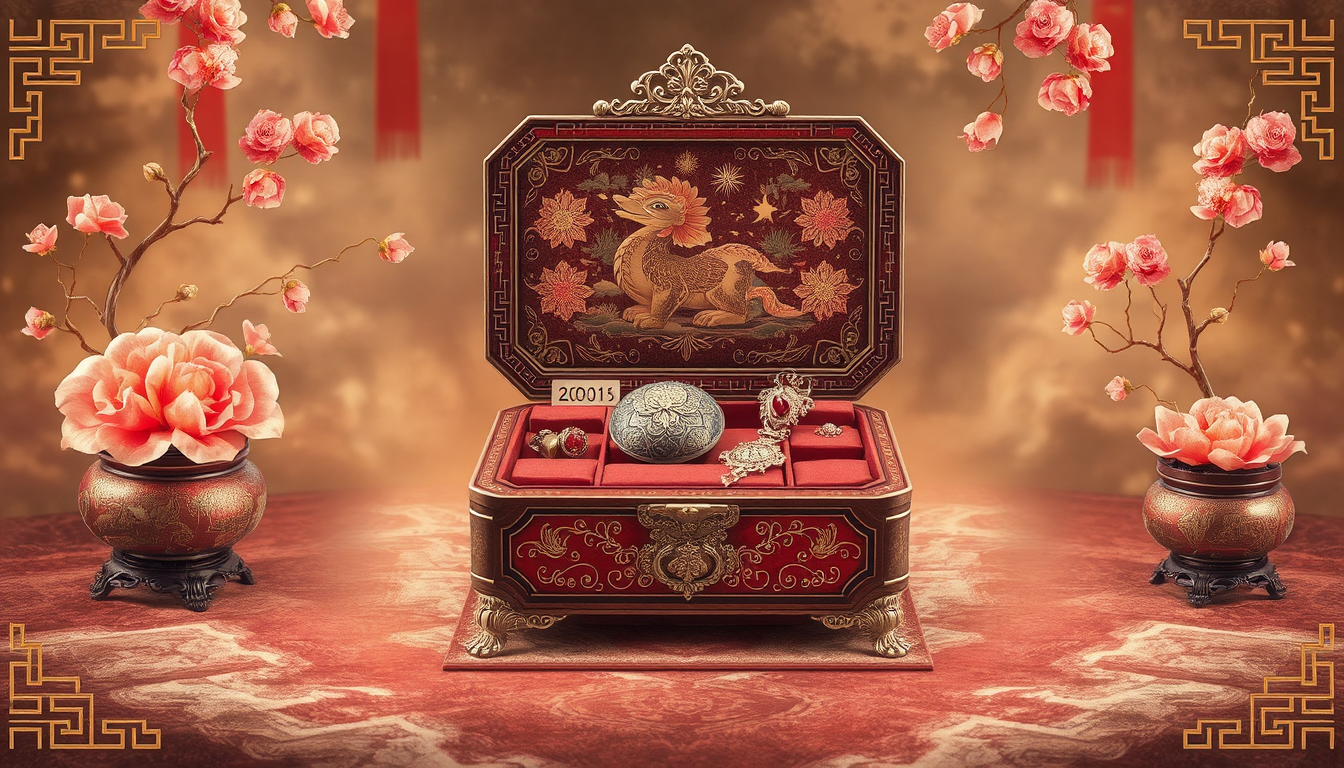
If you want to buy an authentic vintage Chinese jewelry box, knowing how to tell real craftsmanship from modern copies is important. The signs of a box’s age and quality can be found in how it was made, its hardware, and its surface.
It’s best to examine the box in person. Old, dense rosewood feels different from newer, lighter wood. The subtle signs of age and handcraft are often more reliable than any certificate. Here’s what to look for:
Key Markers of Authenticity and Age
-
Examine the Joinery: Flip the box over and inspect the corners. Quality Chinese carpentry with hand cut dovetail corners. These are interlocking joints that are very strong and require finesse to cut. Newer commercially produced boxes are typically nailed or stapled together with wire strapping wrapped around them, or they may be of glued construction.
-
Inspect the Hardware: The brass fittings also speak volumes. And real vintage hardware is typically heavier and thicker than modern remakes. Strive for a natural patina — the dulling of a shine with a faint greenish or darkish tint that grows over decades. modern brass is to thin and not burnished enough or instead too even in patina. See how the patterns in the hardware look like they were done by hand, with subtle variations, rather than machine-perfect.
-
Assess the Surface: True multi-layered lacquer has a depth that’s hard to fake. Look for a deep luster rather than a shiny surface. Very old pieces might have fine cracks in the lacquer from the wood expanding and contracting over many years. Feel any inlays with your fingers. Real mother-of-pearl or jade should feel cool to touch and sit flush with the wood, unlike plastic or fake materials.
-
Check for Signatures or Markings: While most boxes don’t have markings, some high-quality pieces might have a maker’s seal or characters on the bottom or inside a drawer. These are rare, but finding one can mean the piece has a special history.
Preserving Your Treasure: How to Care for Your Chinese Jewelry Box
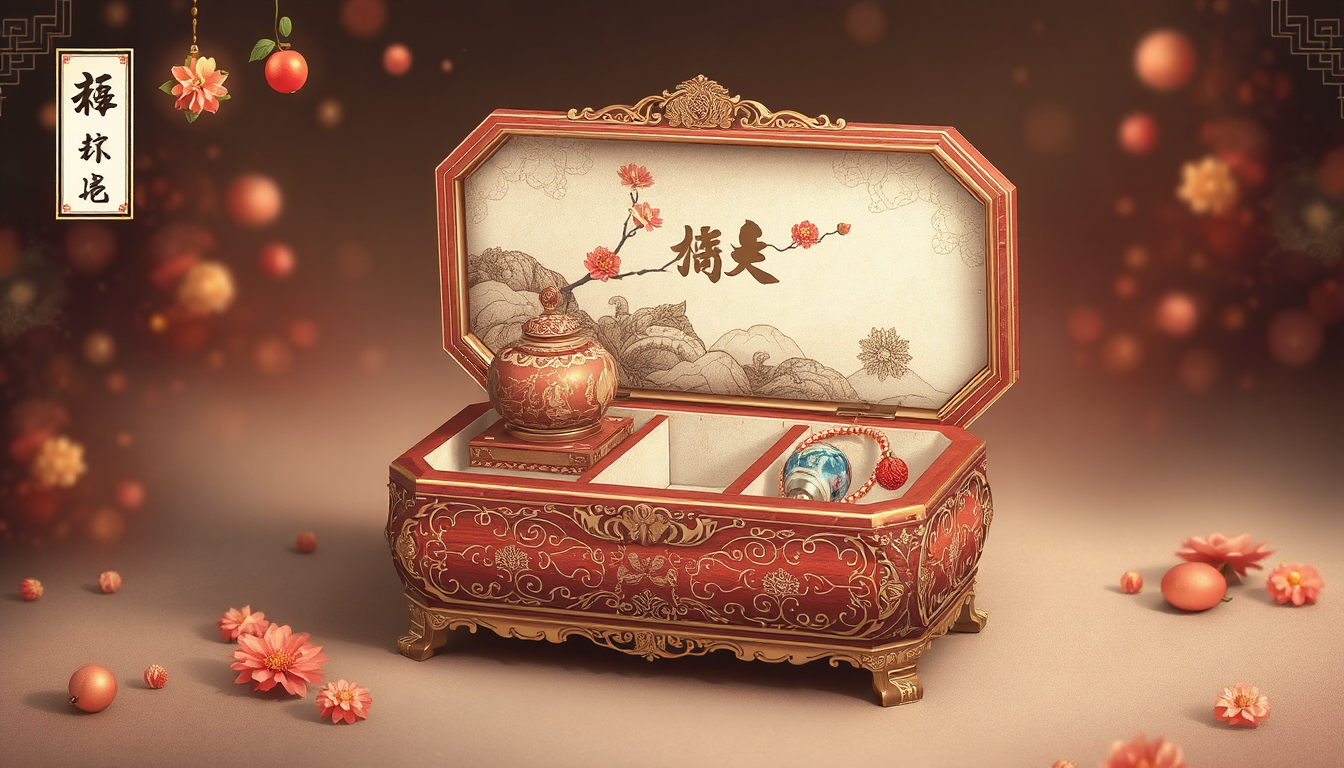
A Chinese jewelry box is durable, but its fine materials need thoughtful care to stay beautiful for decades. Proper care is simple and mainly involves protecting it from harsh conditions and chemicals.
Follow these tips to preserve the wood, lacquer, and fittings:
-
DO: Dust the box periodically with a clean, soft, completely dry microfiber cloth. This steps opposing dust from accumulating on the surface and scratching it.
-
DON’T: Apply chemical furniture polishes, sprays or abrasive cleaners. These can ruin the natural patina of the brass, and the delicate lacquer adds a cloudy or mottled look.
-
DO: Keep the box in a consistent indoor position. Do not put it in direct sunlight, which will fade the finish, or near heating/cooling vents, which make for rapid changes in temperature and humidity, which can warp or crack the wood.
-
DON’T: Put wet objects (like glass or vases). Water can cause permanent stains or ruin the lacquer. Lange warns to avoid introducing sharp objects that could scratch the finish.
-
DO: Ensure that your jewelry is clean and dry before storing. This will also guard the fragile silk lining against stain, damp and grease.
Conclusion: A Cherished Piece of History in Your Hands
We have investigated the many ways the Chinese jewelry box serves as much more than a receptacle. It bears the traces of imperial history, the mark of expert craft, the suggestion of significance.
To have one is to have, to possess, more than an object of beauty. You become the custodian of a story and a tradition, grounded in the appreciation of both the meaning and the history, all in the palm of your hand.
FAQ
-
What makes a Chinese jewelry box different from other jewelry storage options?
Chinese jewelry boxes are typically decorated with symbolic decorations, use traditional joinery techniques, and symbolic colors such as red, as well as carved designs of leaves, flowers and dragons, and will often use precious materials such as well-sourced rosewood, camphor wood, and even use animal glue and lacquer. -
How can I identify an authentic vintage Chinese jewelry box?
You’ll want to shop for hand-cut dovetail joints, aged brass hardware with natural patina, luxurious multilayered lacquer, cool-to-the-touch real inlays of jade or mother-of-pearl. -
What do the common symbols on Chinese jewelry boxes represent?
Dragons and phoenixes signify perfect marriage, peonies wealth and honor, bats good luck and the “Shou” character longevity. -
How should I properly care for my Chinese jewelry box?
Dust with a soft, dry cloth Spraying, antibacterial spay and times with the sun’s direct rays, maintain harmony Always clean before storing jewelries and keep jewelries in closed container. -
What woods are typically used in traditional Chinese jewelry boxes?
Premium woods are rosewood (hongmu) for its sturdy quality and rich color, camphor wood (zhangmu) for its natural insect-resistance, and elm (yumu) for its beautiful grain.

